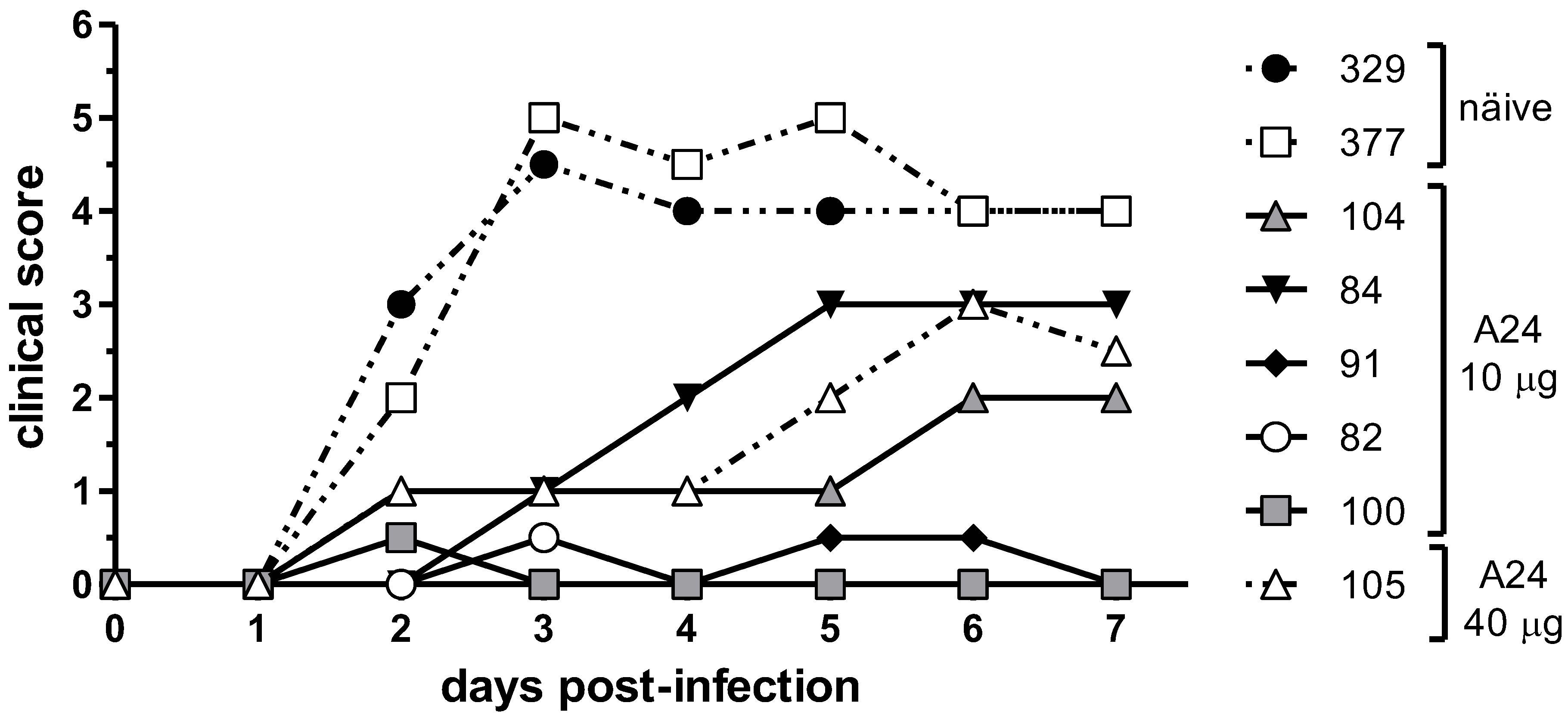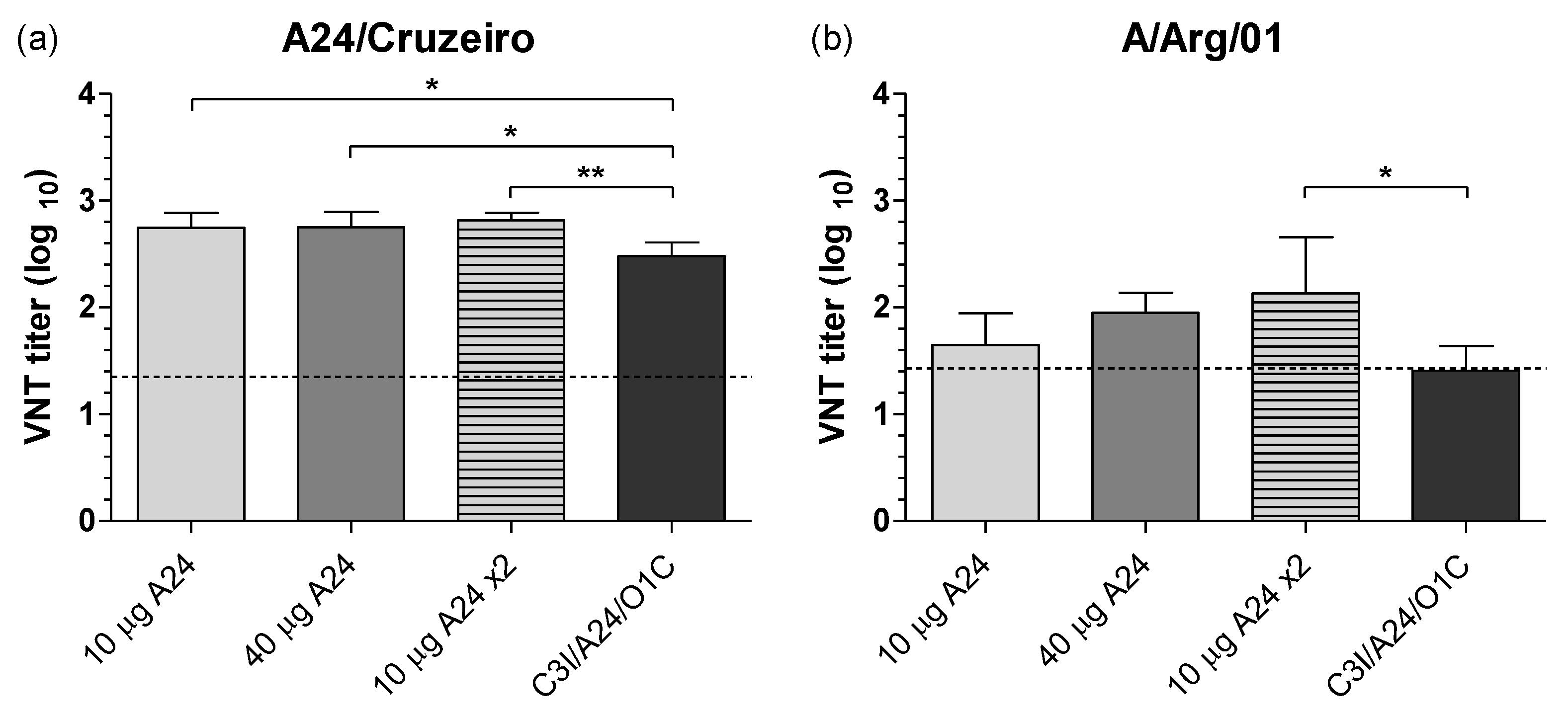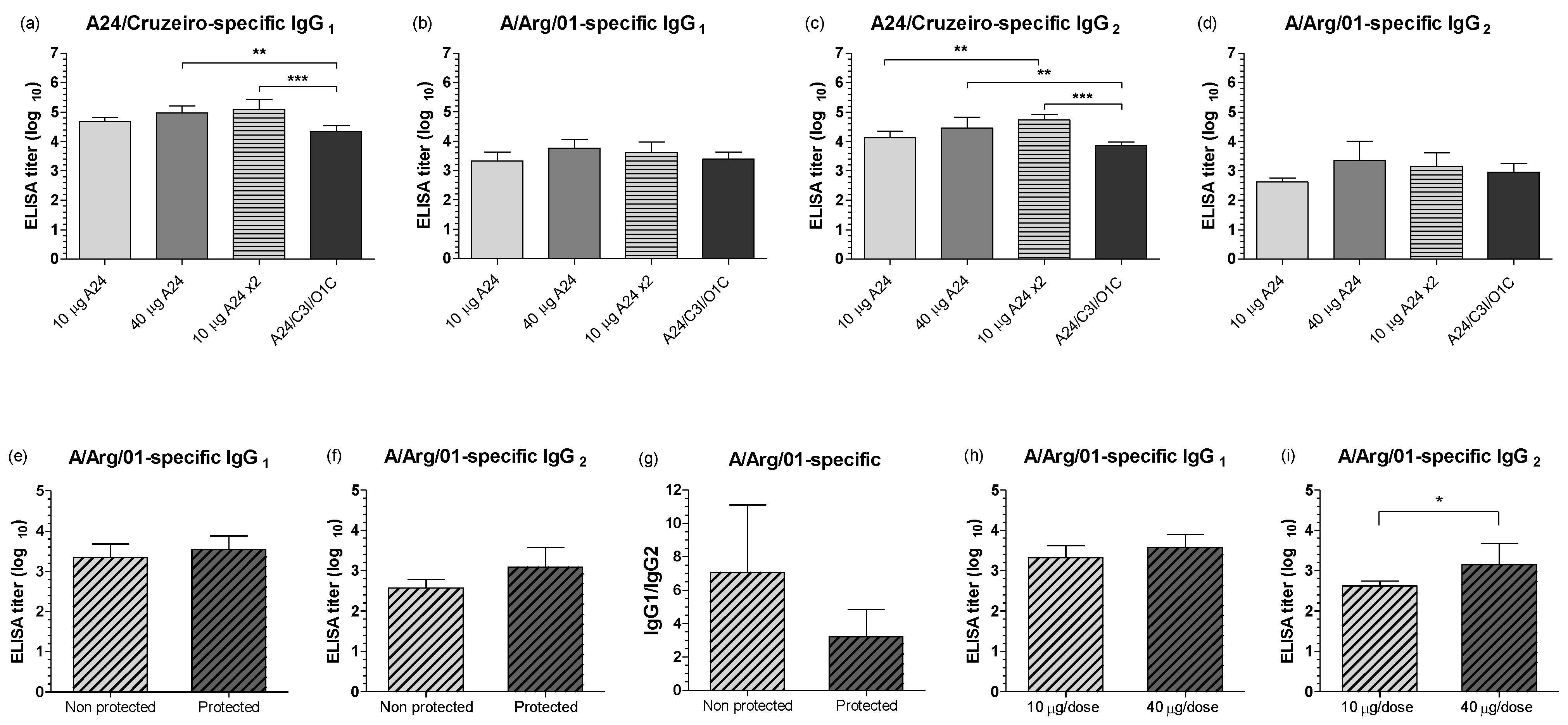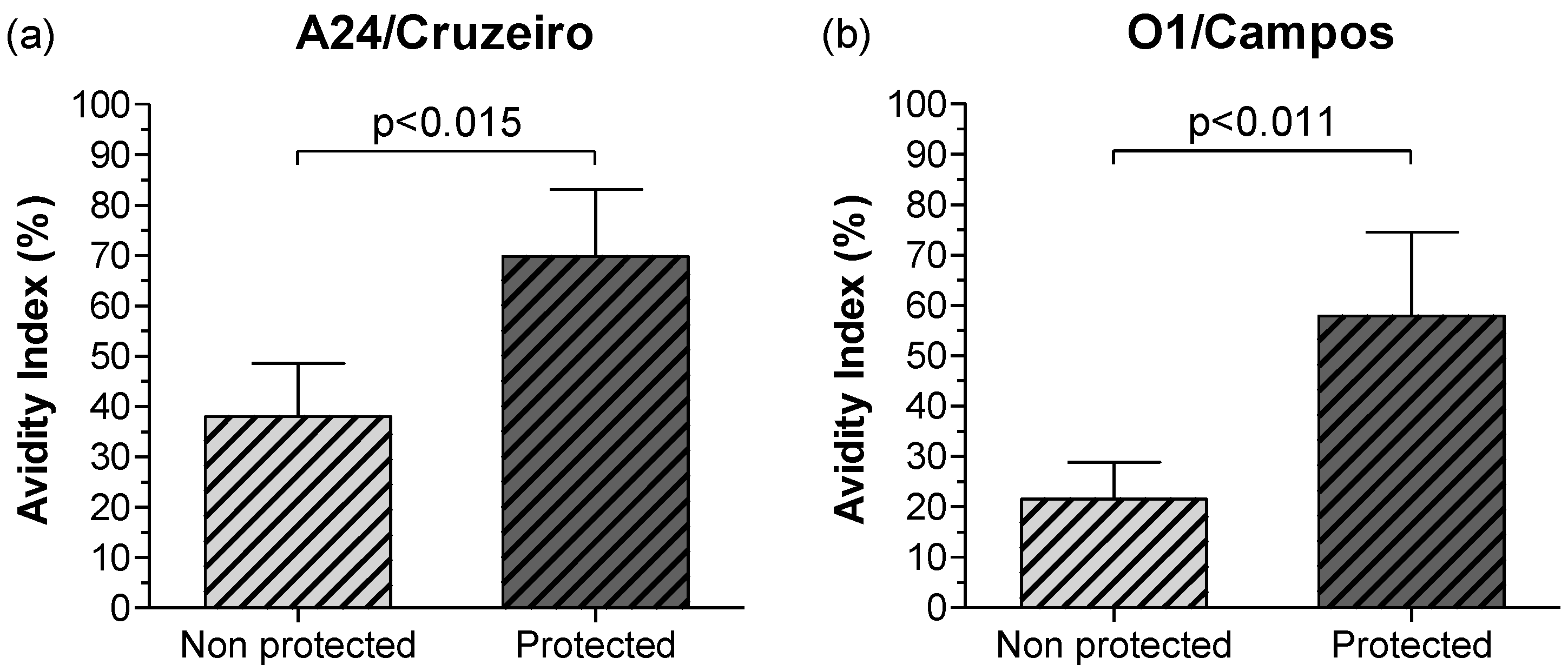Assessment on Different Vaccine Formulation Parameters in the Protection against Heterologous Challenge with FMDV in Cattle
Abstract
:1. Introduction
2. Materials and Methods
2.1. Experimental Animals
2.2. Experimental Design and Sampling
2.3. Experimental Infections and Clinical Assessment of Cattle
2.4. Inactivated FMDV Antigens
2.5. Assessment of FMDV-Specific Total and Neutralizing Antibodies
2.6. Indirect Reference Parameters for Assessment of the Heterologous Protection
2.7. Isotype Profiles and Avidity of the FMDV-Specific Antibody Responses
2.8. Evaluation of the FMDV-Specific Interferon (IFN)-γ Production
2.9. Assessment of Virus Replication
2.10. Statistical Analysis
3. Results
3.1. In Vivo Challenge with a Heterologous Strain of FMDV in Vaccinated Cattle
3.2. Total and Neutralizing Anti-FMDV Antibodies Induced before the Heterologous Challenge
3.3. FMDV-Specific Cellular Immune Responses Induced in Each Experimental Group
3.4. Isotype Profiles of the Anti-FMDV Antibodies Induced before the Heterologous Challenge
3.5. Avidity of the Anti-FMDV Antibodies Induced before the Heterologous Challenge
4. Discussion
Supplementary Materials
Author Contributions
Funding
Institutional Review Board Statement
Informed Consent Statement
Data Availability Statement
Acknowledgments
Conflicts of Interest
Appendix A
References
- WOAH. Chapter 3.1.8 Foot and Mouth Disease. In Manual of Diagnostic Tests and Vaccines for Terrestrial Animals 2022; WOAH, Ed.; WOAH: Hollywood, FL, USA, 2022; Volume 1, pp. 27–30. ISBN 9778-92-95108-18-9. [Google Scholar]
- Domingo, E.; Baranowski, E.; Escarmís, C.; Sobrino, F. Foot-and-Mouth Disease Virus. Comp. Immunol. Microbiol. Infect. Dis. 2002, 25, 297–308. [Google Scholar] [CrossRef]
- Alexandersen, S.; Mowat, N. Foot-and-Mouth Disease: Host Range and Pathogenesis. Curr. Top. Microbiol. Immunol. 2005, 288, 9–42. [Google Scholar] [PubMed]
- Alexandersen, S.; Zhang, Z.; Donaldson, A.I.; Garland, A.J. The Pathogenesis and Diagnosis of Foot-and-Mouth Disease. J. Comp. Pathol. 2003, 129, 1–36. [Google Scholar] [CrossRef]
- Thompson, D.; Muriel, P.; Russell, D.; Osborne, P.; Bromley, A.; Rowland, M.; Creigh-Tyte, S.; Brown, C. Economic Costs of the Foot and Mouth Disease Outbreak in the United Kingdom in 2001. Rev. Sci. Tech. 2002, 21, 675–687. [Google Scholar] [CrossRef]
- Carpenter, T.E.; O’Brien, J.M.; Hagerman, A.D.; McCarl, B.A. Epidemic and Economic Impacts of Delayed Detection of Foot-and-Mouth Disease: A Case Study of a Simulated Outbreak in California. J. Vet. Diagn Investig. 2011, 23, 26–33. [Google Scholar] [CrossRef]
- Perry, B.D.; Rich, K.M. Poverty Impacts of Foot-and-Mouth Disease and the Poverty Reduction Implications of Its Control. Vet. Rec. 2007, 160, 238–241. [Google Scholar] [CrossRef] [PubMed]
- Grubman, M.J.; Baxt, B. Foot-and-Mouth Disease. Clin. Microbiol. Rev. 2004, 17, 465–493. [Google Scholar] [CrossRef] [PubMed]
- Clavijo, A.; Sanchez-Vazquez, M.J.; Buzanovsky, L.P.; Martini, M.; Pompei, J.C.; Cosivi, O. Current Status and Future Prospects to Achieve Foot-and-Mouth Disease Eradication in South America. Transbound. Emerg. Dis. 2017, 64, 31–36. [Google Scholar] [CrossRef] [PubMed]
- Maradei, E.; Malirat, V.; Beascoechea, C.P.; Benitez, E.O.; Pedemonte, A.; Seki, C.; Novo, S.G.; Balette, C.I.; D’Aloia, R.; La Torre, J.L.; et al. Characterization of a Type O Foot-and-Mouth Disease Virus Re-Emerging in the Year 2011 in Free Areas of the Southern Cone of South America and Cross-Protection Studies with the Vaccine Strain in Use in the Region. Vet. Microbiol. 2013, 162, 479–490. [Google Scholar] [CrossRef] [PubMed]
- Maradei, E.; Malirat, V.; Beascoechea, C.P.; Espinoza, A.M.; Novo, S.G.; Smitsaart, E.; Salgado, G.; Mattion, N.; Toledo, J.R.; Bergmann, I.E. Emergence of Antigenic Variants of Foot-and-Mouth Disease Virus Serotype O in Ecuador and Preliminary Evaluation of a Field Strain as a Vaccine Candidate. Vaccine 2014, 32, 2446–2451. [Google Scholar] [CrossRef]
- King, D.P. Foot-and-Mouth Disease Situation Food and Agriculture Organization of the United Nations Monthly Report December 2017; Global Foot-and-Mouth Disease Situation; Food and Agriculture Organization of the United Nations: Rome, Italy, 2017. [Google Scholar]
- Doel, T.R. FMD Vaccines. Virus Res. 2003, 91, 81–99. [Google Scholar] [CrossRef]
- Cox, S.J.; Parida, S.; Voyce, C.; Reid, S.M.; Hamblin, P.A.; Hutchings, G.; Paton, D.J.; Barnett, P.V. Further Evaluation of Higher Potency Vaccines for Early Protection of Cattle against FMDV Direct Contact Challenge. Vaccine 2007, 25, 7687–7695. [Google Scholar] [CrossRef] [PubMed]
- Pega, J.; Di Giacomo, S.; Bucafusco, D.; Schammas, J.M.; Malacari, D.; Barrionuevo, F.; Capozzo, A.V.; Rodriguez, L.L.; Borca, M.V.; Perez-Filgueira, M. Systemic Foot-and-Mouth Disease Vaccination in Cattle Promotes Specific Antibody-Secreting Cells at the Respiratory Tract and Triggers Local Anamnestic Responses upon Aerosol Infection. J. Virol. 2015, 89, 9581–9590. [Google Scholar] [CrossRef] [PubMed]
- Grant, C.F.J.; Carr, B.V.; Singanallur, N.B.; Morris, J.; Gubbins, S.; Hudelet, P.; Ilott, M.; Charreyre, C.; Vosloo, W.; Charleston, B. The B-Cell Response to Foot-and-Mouth-Disease Virus in Cattle Following Vaccination and Live-Virus Challenge. J. Gen. Virol. 2016, 97, 2201–2209. [Google Scholar] [CrossRef] [PubMed]
- Paton, D.J.; Valarcher, J.F.; Bergmann, I.; Matlho, O.G.; Zakharov, V.M.; Palma, E.L.; Thomson, G.R. Selection of Foot and Mouth Disease Vaccine Strains—A Review. Rev. Sci. Tech. 2005, 24, 981–993. [Google Scholar] [CrossRef] [PubMed]
- Bergmann, I.E.; Malirat, V.; Pedemonte, A.; Maradei, E. Challenges in Foot-and-Mouth Disease Virus Strain Selection as an Input to Attain Broad Vaccine Intraserotype Cross-Protection. Expert Rev. Vaccines 2021, 20, 13–22. [Google Scholar] [CrossRef] [PubMed]
- Barteling, S.J.; Meloen, R.H. A Simple Method for the Quantification of 140S Particles of Foot-and-Mouth Disease Virus (FMDV). Arch. Gesamte Virusforsch. 1974, 45, 362–364. [Google Scholar] [CrossRef]
- Pega, J.; Bucafusco, D.; Di Giacomo, S.; Schammas, J.M.; Malacari, D.; Capozzo, A.V.; Arzt, J.; Perez-Beascoechea, C.; Maradei, E.; Rodriguez, L.L.; et al. Early Adaptive Immune Responses in the Respiratory Tract of Foot-and-Mouth Disease Virus-Infected Cattle. J. Virol. 2013, 87, 2489–2495. [Google Scholar] [CrossRef] [PubMed]
- Hamblin, C.; Barnett, I.T.; Hedger, R.S. A New Enzyme-Linked Immunosorbent Assay (ELISA) for the Detection of Antibodies against Foot-and-Mouth Disease Virus. I. Development and Method of ELISA. J. Immunol. Methods 1986, 93, 115–121. [Google Scholar] [CrossRef]
- Periolo, O.H.; Seki, C.; Grigera, P.R.; Robiolo, B.; Fernandez, G.; Maradei, E.; D’Aloia, R.; La Torre, J.L. Large-Scale Use of Liquid-Phase Blocking Sandwich ELISA for the Evaluation of Protective Immunity against Aphthovirus in Cattle Vaccinated with Oil-Adjuvanted Vaccines in Argentina. Vaccine 1993, 11, 754–760. [Google Scholar] [CrossRef]
- Maradei, E.; La Torre, J.; Robiolo, B.; Esteves, J.; Seki, C.; Pedemonte, A.; Iglesias, M.; D’Aloia, R.; Mattion, N. Updating of the Correlation between LpELISA Titers and Protection from Virus Challenge for the Assessment of the Potency of Polyvalent Aphtovirus Vaccines in Argentina. Vaccine 2008, 26, 6577–6586. [Google Scholar] [CrossRef] [PubMed]
- Mattion, N.; Konig, G.; Seki, C.; Smitsaart, E.; Maradei, E.; Robiolo, B.; Duffy, S.; Leon, E.; Piccone, M.; Sadir, A.; et al. Reintroduction of Foot-and-Mouth Disease in Argentina: Characterisation of the Isolates and Development of Tools for the Control and Eradication of the Disease. Vaccine 2004, 22, 4149–4162. [Google Scholar] [CrossRef]
- Reed, L.J.; Muench, H. A Simple Method of Estimating Fifty per Cent Endpoints. Am. J. Epidemiol. 1938, 27, 493–497. [Google Scholar] [CrossRef]
- SENASA. Reglamentación que Permite el Control de las Vacunas Destinadas a la Prevención de la Fiebre Aftosa 351/2006; SENASA: Buenos Aires, Argentina, 2006. [Google Scholar]
- PANAFTOSA. Subproyecto a Correlación de las Técnicas de Control de Potencia de las Vacunas Contra la Fiebre Aftosa en Los Países de la Cuenca del río de la Plata; PANAFTOSA: Santo Domingo, Dominican Republic, 1994. [Google Scholar]
- Perez-Beascoechea, C.; Galdo-Novo, S.; D’Aloia, S.; Esteves-Madero, J. Virus de Fiebre Aftosa A Argentina 2001: Correlación de Títulos de Anticuerpos Neutralizantes Con La Protección al Desafío Viral in Vivo Por Medio de La Expectativa Porcentual de Protección. Desarrollo de Una Curva de Correlación de Tipo Logit. In Proceedings of the XIII Congreso Argentino de Microbiología, Buenos Aires, Argentina, 23–26 September 2013. [Google Scholar]
- Lavoria, M.Á.; Di-Giacomo, S.; Bucafusco, D.; Franco-Mahecha, O.L.; Pérez-Filgueira, D.M.; Capozzo, A.V. Avidity and Subtyping of Specific Antibodies Applied to the Indirect Assessment of Heterologous Protection against Foot-and-Mouth Disease Virus in Cattle. Vaccine 2012, 30, 6845–6850. [Google Scholar] [CrossRef] [PubMed]
- Bucafusco, D.; Di Giacomo, S.; Pega, J.; Schammas, J.M.; Cardoso, N.; Capozzo, A.V.; Perez-Filgueira, M. Foot-and-Mouth Disease Vaccination Induces Cross-Reactive IFN-Gamma Responses in Cattle That Are Dependent on the Integrity of the 140S Particles. Virology 2015, 476, 11–18. [Google Scholar] [CrossRef] [PubMed]
- Brehm, K.E.; Kumar, N.; Thulke, H.H.; Haas, B. High Potency Vaccines Induce Protection against Heterologous Challenge with Foot-and-Mouth Disease Virus. Vaccine 2008, 26, 1681–1687. [Google Scholar] [CrossRef] [PubMed]
- Nagendrakumar, S.B.; Srinivasan, V.A.; Madhanmohan, M.; Yuvaraj, S.; Parida, S.; Di Nardo, A.; Horsington, J.; Paton, D.J. Evaluation of Cross-Protection between O1 Manisa and O1 Campos in Cattle Vaccinated with Foot-and-Mouth Disease Virus Vaccine Incorporating Different Payloads of Inactivated O1 Manisa Antigen. Vaccine 2011, 29, 1906–1912. [Google Scholar] [CrossRef]
- Duque, H.; Naranjo, J.; Carrillo, C.; Burbano, A.; Vargas, J.; Pauszek, L.; Olesen, I.; Sanchez-Vazquez, M.J.; Cosivi, O.; Allende, R.M. Protection Induced by a Commercial Bivalent Vaccine against Foot-and-Mouth Disease 2010 Field Virus from Ecuador. Vaccine 2016, 34, 4140–4144. [Google Scholar] [CrossRef]
- Singanallur, N.B.; Pacheco, J.M.; Arzt, J.; Stenfeldt, C.; Fosgate, G.T.; Rodriguez, L.; Vosloo, W. Efficacy of a High Potency O1 Manisa Monovalent Vaccine against Heterologous Challenge with Foot-and-Mouth Disease Virus of O/SEA/Mya-98 Lineage in Sheep. Antiviral. Res. 2017, 145, 114–122. [Google Scholar] [CrossRef]
- Singanallur, N.B.; Dekker, A.; Eblé, P.L.; van Hemert-Kluitenberg, F.; Weerdmeester, K.; Horsington, J.J.; Vosloo, W. Emergency FMD Serotype O Vaccines Protect Cattle against Heterologous Challenge with a Variant Foot-and-Mouth Disease Virus from the O/ME-SA/Ind2001 Lineage. Vaccines 2021, 9, 1110. [Google Scholar] [CrossRef] [PubMed]
- Singanallur, N.B.; Eblé, P.L.; Ludi, A.B.; Statham, B.; Bin-Tarif, A.; King, D.P.; Dekker, A.; Vosloo, W. A Vaccine Based on the A/ASIA/G-VII Lineage of Foot-and-Mouth Disease Virus Offers Low Levels of Protection against Circulating Viruses from the A/ASIA/Iran-05 Lineage. Viruses 2022, 14, 97. [Google Scholar] [CrossRef] [PubMed]
- Dekker, A.; Sanz-Bernardo, B.; Singanallur, N.B.; Ludi, A.B.; Horsington, J.; Eblé, P.L.; King, D.P.; Vosloo, W. Cross-Protection Induced by a A/MAY/97 Emergency Vaccine Against Intra-Serotype Heterologous Challenge with a Foot-and-Mouth Disease Virus from the A/ASIA/G-VII Lineage. Vaccines 2020, 8, 24. [Google Scholar] [CrossRef] [PubMed]
- Asfor, A.S.; Upadhyaya, S.; Knowles, N.J.; King, D.P.; Paton, D.J.; Mahapatra, M. Novel Antibody Binding Determinants on the Capsid Surface of Serotype O Foot-and-Mouth Disease Virus. J. Gen. Virol. 2014, 95, 1104–1116. [Google Scholar] [CrossRef] [PubMed]
- He, Y.; Li, K.; Cao, Y.; Sun, Z.; Li, P.; Bao, H.; Wang, S.; Zhu, G.; Bai, X.; Sun, P.; et al. Structures of Foot-and-Mouth Disease Virus with Neutralizing Antibodies Derived from Recovered Natural Host Reveal a Mechanism for Cross-Serotype Neutralization. PLoS Pathog. 2021, 17, e1009507. [Google Scholar] [CrossRef] [PubMed]
- Li, K.; He, Y.; Wang, L.; Li, P.; Wang, S.; Sun, P.; Bao, H.; Cao, Y.; Liu, X.; Zhu, G.; et al. Two Cross-Protective Antigen Sites on Foot-and-Mouth Disease Virus Serotype O Structurally Revealed by Broadly Neutralizing Antibodies from Cattle. J. Virol. 2021, 95, JVI00881-21. [Google Scholar] [CrossRef]
- Goris, N.; Maradei, E.; D’Aloia, R.; Fondevila, N.; Mattion, N.; Perez, A.; Smitsaart, E.; Nauwynck, H.J.; La Torre, J.; Palma, E.; et al. Foot-and-Mouth Disease Vaccine Potency Testing in Cattle Using Homologous and Heterologous Challenge Strains: Precision of the “Protection against Podal Generalisation” Test. Vaccine 2008, 26, 3432–3437. [Google Scholar] [CrossRef] [PubMed]
- Barrionuevo, F.; Di Giacomo, S.; Bucafusco, D.; Ayude, A.; Schammas, J.; Miraglia, M.C.; Capozzo, A.; Borca, M.V.; Perez-Filgueira, M. Systemic Antibodies Administered by Passive Immunization Prevent Generalization of the Infection by Foot-and-Mouth Disease Virus in Cattle after Oronasal Challenge. Virology 2018, 518, 143–151. [Google Scholar] [CrossRef] [PubMed]
- Gordon, L.; Mabbott, N.; Wells, J.; Kulik, L.; Juleff, N.; Charleston, B.; Perez-Martin, E. Foot-and-Mouth Disease Virus Localisation on Follicular Dendritic Cells and Sustained Induction of Neutralising Antibodies Is Dependent on Binding to Complement Receptors (CR2/CR1). PLoS Pathog. 2022, 18, e1009942. [Google Scholar] [CrossRef]
- Steward, M.W.; Stanley, C.M.; Dimarchi, R.; Mulcahy, G.; Doel, T.R. High-Affinity Antibody Induced by Immunization with a Synthetic Peptide Is Associated with Protection of Cattle against Foot-and-Mouth Disease. Immunology 1991, 72, 99–103. [Google Scholar]
- Newman, M.A.; Mainhart, C.R.; Mallett, C.P.; Lavoie, T.B.; Smith-Gill, S.J. Patterns of Antibody Specificity during the BALB/c Immune Response to Hen Eggwhite Lysozyme. J. Immunol. 1992, 149, 3260–3272. [Google Scholar]
- Chaudhury, S.; Reifman, J.; Wallqvist, A. Simulation of B Cell Affinity Maturation Explains Enhanced Antibody Cross-Reactivity Induced by the Polyvalent Malaria Vaccine AMA1. J. Immunol. 2014, 193, 2073–2086. [Google Scholar] [CrossRef]
- Carr, B.V.; Lefevre, E.A.; Windsor, M.A.; Inghese, C.; Gubbins, S.; Prentice, H.; Juleff, N.D.; Charleston, B. CD4+ T-Cell Responses to Foot-and-Mouth Disease Virus in Vaccinated Cattle. J. Gen. Virol. 2013, 94, 97–107. [Google Scholar] [CrossRef] [PubMed]
- Scott, K.A.; Rathogwa, N.M.; Capozzo, A.V.; Maree, F.F. Evaluation of Immune Responses of Stabilised SAT2 Antigens of Foot-and-Mouth Disease in Cattle. Vaccine 2017, 35, 5426–5433. [Google Scholar] [CrossRef]
- Mitoma, S.; Carr, B.V.; Harvey, Y.; Moffat, K.; Sekiguchi, S.; Charleston, B.; Norimine, J.; Seago, J. The Detection of Long-Lasting Memory Foot-and-Mouth Disease (FMD) Virus Serotype O-Specific CD4+ T Cells from FMD-Vaccinated Cattle by Bovine Major Histocompatibility Complex Class II Tetramer. Immunology 2021, 164, 266–278. [Google Scholar] [CrossRef]









| Experimental Group | % of In Vivo Protection | Animal # | In Vivo Protection | NSP 7 dpi | VI 4 dpi |
|---|---|---|---|---|---|
| A24 10 µg | 60% | 82 | yes | - | ND |
| 84 | no | - | + | ||
| 91 | yes | + | - | ||
| 100 | yes | + | ND | ||
| 104 | no | + | + | ||
| A24 40 µg | 80% | 83 | yes | - | ND |
| 85 | yes | + | ND | ||
| 93 | yes | - | - | ||
| 101 | yes | - | ND | ||
| 105 | no | - | + | ||
| A24 10 µg × 2 | 100% | 86 | yes | - | ND |
| 92 | yes | - | ND | ||
| 96 | yes | - | ND | ||
| 102 | yes | - | - | ||
| 106 | yes | - | ND | ||
| A24/C3I/O1C | 100% | 87 | yes | + | ND |
| 97 | yes | - | - | ||
| 103 | yes | - | ND | ||
| 108 | yes | + | ND | ||
| 323 | yes | + | ND | ||
| naïve | 0% | 329 | no | + | + |
| 377 | no | + | + |
Publisher’s Note: MDPI stays neutral with regard to jurisdictional claims in published maps and institutional affiliations. |
© 2022 by the authors. Licensee MDPI, Basel, Switzerland. This article is an open access article distributed under the terms and conditions of the Creative Commons Attribution (CC BY) license (https://creativecommons.org/licenses/by/4.0/).
Share and Cite
Di Giacomo, S.; Bucafusco, D.; Schammas, J.M.; Pega, J.; Miraglia, M.C.; Barrionuevo, F.; Capozzo, A.V.; Perez-Filgueira, D.M. Assessment on Different Vaccine Formulation Parameters in the Protection against Heterologous Challenge with FMDV in Cattle. Viruses 2022, 14, 1781. https://doi.org/10.3390/v14081781
Di Giacomo S, Bucafusco D, Schammas JM, Pega J, Miraglia MC, Barrionuevo F, Capozzo AV, Perez-Filgueira DM. Assessment on Different Vaccine Formulation Parameters in the Protection against Heterologous Challenge with FMDV in Cattle. Viruses. 2022; 14(8):1781. https://doi.org/10.3390/v14081781
Chicago/Turabian StyleDi Giacomo, Sebastián, Danilo Bucafusco, Juan Manuel Schammas, Juan Pega, María Cruz Miraglia, Florencia Barrionuevo, Alejandra Victoria Capozzo, and Daniel Mariano Perez-Filgueira. 2022. "Assessment on Different Vaccine Formulation Parameters in the Protection against Heterologous Challenge with FMDV in Cattle" Viruses 14, no. 8: 1781. https://doi.org/10.3390/v14081781





